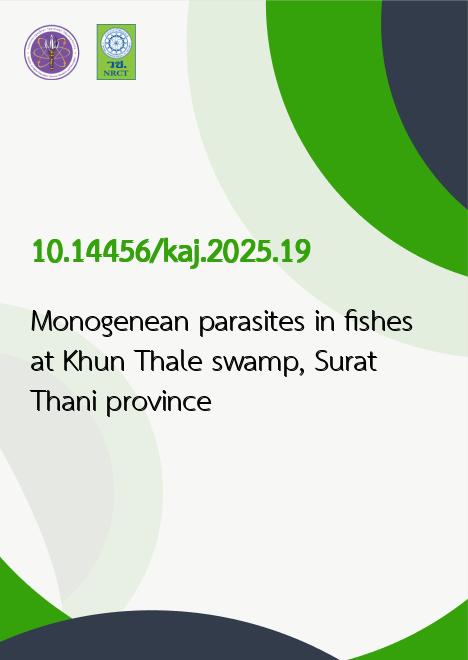
|
Monogenean parasites in fishes at Khun Thale swamp, Surat Thani province |
|---|---|
| รหัสดีโอไอ | |
| Creator | Kanda Kamchoo |
| Title | Monogenean parasites in fishes at Khun Thale swamp, Surat Thani province |
| Contributor | Sayfon Tidkongrach, Duangrat Chookird |
| Publisher | Faculty of Agriculture |
| Publication Year | 2568 |
| Journal Title | Khon Kaen Agriculture Journal |
| Journal Vol. | 53 |
| Journal No. | 2 |
| Page no. | 258-271 |
| Keyword | freshwater fish, brackishwater fish, Monogenea, Monopisthocotylea, Khun Thale swamp |
| URL Website | https://li01.tci-thaijo.org/index.php/agkasetkaj |
| Website title | Khon Kaen Agriculture Journal |
| ISSN | 3027-6497 (Online) |
| Abstract | Monogenean parasites are external parasites that can cause disease in the skin and gills of fish. These parasites are common in freshwater, brackish, and marine fish. The investigation was performed at Khun Thale swamp, Surat Thani province. The Khun Thale swamp is a part of the Tapi River’s catchment area. The swamp is an ecotone between a freshwater swamp and marine water at an estuary providing the unique habitat that fosters a surprising diversity of fish. This study aimed to determine the prevalence of monogenean parasites in fish from Khun Thale swamp, Surat Thani province. Fish samples were randomly collected by the local fishermen during two seasons in 2020: the summer season (February-April) and the rainy season (September-November). For the fish parasite examination, a total of 1,074 fish were collected, belonging to 16 families, 27 genera, and 33 species. The prevalence of infection was 29.01% (150/517) in the summer season and 28.36% (158/557) in the rainy season. Sixteen species of fish were infected with monogenean parasites. Nine species of monogenean were found belonging to Order Monopisthocotylea, including Ciclidogyrus halli, Dactylogyrus sp.I, Dactylogyrus sp. II, Dactylogyrus sp. III, Dactylogyrus sp. IV, Laticola paralatesi, Metahaliotrema ypsilocleithrum, Thaparocleidus siamensis and T. ophicephali. Monogenean parasites feed on the mucus and blood of the fish, and they can cause hemorrhage, gill damage, hyperplasia and gill lamellar fusion. In severe cases, monogenean infections can lead to fish death. |
